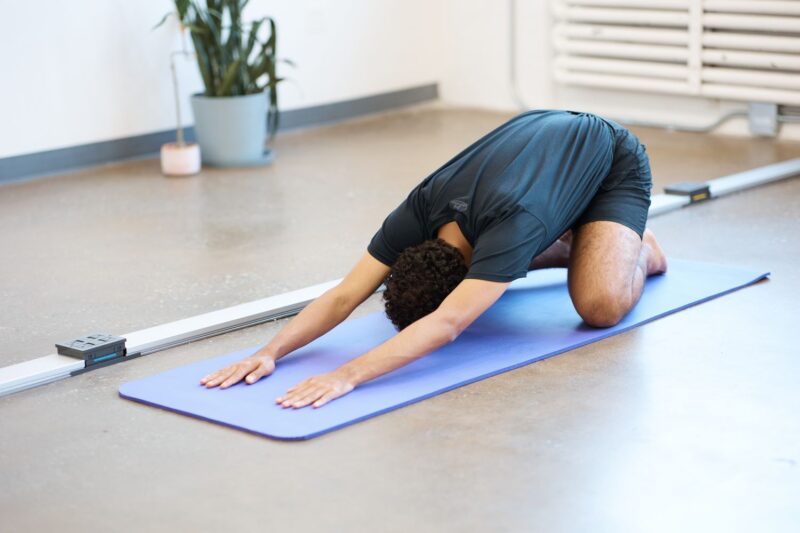Choosing the right thickness matters for your practice. Different styles need different levels of support and comfort. Using the proper mat ensures stability and improves your experience. This article helps you find the best mat thickness for various styles.
It Depends on Your Needs
Choosing the right thickness depends on your needs and preferences. Different styles and comfort levels require various thicknesses. Here, we explore key factors to help you make the right choice.
Type of Yoga

- Hatha: Uses slower movements. Best thickness: 4mm to 6mm for comfort and support.
- Vinyasa: Involves continuous flow. Best thickness: 3mm to 5mm for a balance of cushioning and stability.
- Ashtanga: Intense and physically demanding. Best thickness: 3mm to 4mm for stability during complex poses.
- Restorative: Focuses on relaxation. Best thickness: 6mm to 8mm for maximum comfort and support.
- Bikram/Hot: Practiced in heated rooms. Best thickness: 4mm to 5mm for adequate cushioning and grip.
Different Types of Mats

Thin (1mm to 3mm)
- Easy to Carry: Lightweight, great for travel.
- Better Balance: Strong connection to the floor.
- Affordable: Usually costs less than thicker mats.
Medium (4mm to 5mm)
- Versatile: Suitable for most yoga styles.
- Durable: Long-lasting with proper care.
- Balanced Support: Enough cushioning without losing stability.
Thick (6mm to 8mm+)
- Extra Comfort: Ideal for gentle and restorative yoga.
- Joint Support: Good for those with joint issues.
- Warmth: Insulates against cold floors.
Also Consider
- Style: Identify the main type of yoga you practice. Your mat should suit the demands of your routine.
- Comfort: Think about your comfort needs. Thicker ones provide more padding for sensitive joints.
- Portability: Consider how often you travel with your mat. A thinner one is easier to carry.
- Practice Surface: Consider where you practice. Hard floors may need thicker for comfort, while carpets might be fine with thinner mats.
How Does Thickness Affect the Performance?
Choosing the right thickness directly impacts your performance during practice. The thickness influences your stability, comfort, and overall experience. Here’s a detailed look at how different thicknesses affect your performance.
Stability and Balance

- Thin (1mm to 3mm): These mats provide a strong connection to the floor, enhancing stability and balance. Ideal for poses that require a firm grounding. Perfect for standing and balancing poses.
- Medium (4mm to 5mm): Offer a balance between comfort and stability. Suitable for most yoga styles. Provide enough support while maintaining a good level of stability.
- Thick (6mm to 8mm+): While offering more cushioning, thick mats can sometimes compromise stability. This can make balancing poses more challenging.
Comfort and Support
- Thin: Less cushioning can lead to discomfort, especially on hard floors. Not recommended for those with sensitive joints.
- Medium: Provide adequate cushioning for most practitioners. Offer a good balance of comfort without being too soft.
- Thick: Best for those needing extra support. Ideal for restorative yoga or practitioners with joint issues.
Portability and Convenience

- Thin: Easy to carry, making them ideal for travel. Lightweight and compact.
- Medium: Offer a balance between portability and comfort. Suitable for regular practice and moderate travel.
- Thick: Heavier and bulkier. Less convenient for transport but offers superior comfort.
Durability and Lifespan
- Thin: Tend to wear out faster, especially with frequent use. It may need to be replaced more often.
- Medium: Durable and long-lasting with proper care. Provide a good lifespan for regular practitioners.
- Thick: Generally durable but can be prone to compression over time. Best suited for less intensive practices.
Other Important Factors to Consider
When choosing a yoga mat, several factors besides thickness are crucial. Each aspect can significantly impact your yoga experience. Here’s what you need to know:
Material

The material affects the mat’s feel, grip, durability, and environmental impact.
Options:
- PVC (Vinyl): Durable and sticky, good for grip.
- Natural Rubber: Excellent traction and cushioning but avoid if you have latex allergies.
- Jute: Eco-friendly with a rough texture.
- Organic Cotton/Natural Cotton: Eco-friendly and soft, less spongy.
Buying tips:
- If you have latex allergies, avoid rubber mats.
- PVC mats last long and provide good cushioning.
- For eco-friendly options, consider jute or organic cotton.
Texture
Texture impacts traction and prevents slipping.
- Smooth: Usually PVC, offers a sticky feel.
- Textured: Rubber, jute, or cotton with raised patterns for grip.
If you need extra grip, choose a textured mat. For a smoother feel, go with PVC mats.
Stickiness
Stickiness helps maintain your pose without slipping.
Ensure the mat is clean to maintain stickiness. If you prefer less texture but need a grip, PVC is a good choice.
And In the End, It’s Your Choice
The information above surely can help you decide on buying the right yoga mat. But still, personal preferences are the most important detail. So, if you prefer a little thicker mat, just go for it. Those with more experience usually have several models for different types of exercises. You should consider that as well.







